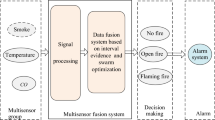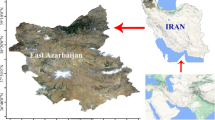Abstract
Recently, neutrosophic systems modeling gained great attention in indeterminacy handling. Generating suitable membership, indeterminacy and non-membership functions for neutrosophic temperature variable in the forest fires data is a challenging problem. This paper presents a platform for integrating information theory measures with particle swarm optimization as a meta-heuristic algorithm to model a neutrosophic variable out of concrete data. Particle swarm optimization is an efficient population-based algorithm presented to find membership, indeterminacy and non-membership optimal partitions. The integrated hybrid model of information theory measures and particle swarm optimization is presented. The experimental comparisons are applied between the proposed technique and the Fuzzy C-Mean MATLAB tool for generating fuzzy membership functions. Extensive graphical results of the temperature variable of the forest fires data set and the conversion rates are provided to demonstrate the effectiveness of the proposed paradigm. The conversion rates of the proposed technique show that the optimal membership and non-membership functions are concluded after 10 and 17 iterations, respectively, which is a feasibly fast rate. Also, the proposed technique generated relatively similar functions’ subsets for the forest fire temperature variable, while the Fuzzy C-Mean clearly shifted the functions’ subsets during the experiments. Calculating the indeterminacy of the temperature in forest fire data will contribute to forecasting these fires accurately.












Similar content being viewed by others
References
Hutto L et al (2016) Toward a more ecologically informed view of severe forest fires. Ecosphere 7(2):01255
Fernandes PM et al (2017) On the reactive nature of forest fire-related legislation in Portugal: a comment on Mourão and Martinho (2016). Land Use Policy 60:12–15
El Aziz MA, Hemdan AM, Ewees AA, Elhoseny M, Shehab A, Hassanien AE, Xiong S (2017) Prediction of Biochar yield using adaptive neuro-fuzzy inference system with particle swarm optimization. In: IEEE PES PowerAfrica Conference, June 27–30. IEEE, Accra, pp 115–120. https://doi.org/10.1109/powerafrica.2017.7991209
Ewees AA, El Aziz MA, Elhoseny M (2017) Social-spider optimization algorithm for improving ANFIS to predict Biochar yield. In: 8th International Conference on Computing, Communication and Networking Technologies (8ICCCNT), July 3–5. IEEE, Delhi
Alblowi SA, Salama AA, Eisa M (2013) New concepts of neutrosophic sets. Int J Math Comput Appl Res (IJMCAR) 3(4):95–102
Hanafy IM, Salama AA, Mahfouz KM (2013) Neutrosophic classical events and its probability. Int J Math Comput Appl Res (IJMCAR) 3(1):171–178
Gafar MG, El-Henawy I (2017) Integrated framework of optimization technique and information theory measures for modeling neutrosophic variables neutrosophic sets and systems. Peer Rev 15:175
Tharwat A, Elhoseny M, Hassanien AE, Gabel T, Kumar NA (2018) Intelligent beziér curve-based path planning model using chaotic particle swarm optimization algorithm, cluster computing. Springer, Berlin, pp 1–22. https://doi.org/10.1007/s10586-018-2360-3
Kennedy J (2011) Particle swarm optimization. Encyclopedia of machine learning. Springer, New York, pp 760–766
Osman IH, Kelly JP (2012) Meta-heuristics: theory and applications. Springer, Berlin
Makrehchi M, Basir O, Kamel M (2003) Generation of fuzzy membership function using information theory measures and genetic algorithm. In: International Fuzzy Systems Association World Congress. Springer, Berlin, pp 603–610
Paninski L (2003) Estimation of entropy and mutual information. Neural Comput 15(6):1191–1253
Liao TW, Celmins AK, Hammell RJ II (2003) A fuzzy c-means variant for the generation of fuzzy term sets. Fuzzy Sets Syst 135(2):241–257
Gamal M et al (2012) A hybrid of self organized feature maps and parallel genetic algorithms for uncertain knowledge. Int J Comput Appl 60(6):17–25
Iliadis L et al (2010) A fuzzy inference system using gaussian distribution curves for forest fire risk estimation. In: IFIP International Conference on Artificial Intelligence Applications and Innovations. Springer, Berlin, pp 376–386
Wijayanto AK et al (2017) Classification model for forest fire hotspot occurrences prediction using ANFIS algorithm. In: IOP Conference Series: Earth and Environmental Science, vol 54, no 1. IOP Publishing
Soto MEC (2012) The identification and assessment of areas at risk of forest fire using fuzzy methodology. Appl Geogr 35(1–2):199–207
Rajabi M et al (2013) An innovative method for forest fire risk zoning map using fuzzy inference system and GIS. Int J Sci Technol Res 2:57–64
Kamran KV et al (2014) Forest fire risk assessment using multicriteria analysis: a case study Kaleybar forest. In: International conference on Agriculture, Environment and Biological Sciences (ICFAE’14), Antalya
Tsataltzinos T, Iliadis L, Spartalis S (2011) A generalized fuzzy-rough set application for forest fire risk estimation feature reduction. In: Iliadis L, Maglogiannis I, Papadopoulos H (eds) Artificial intelligence applications and innovations. Springer, Berlin, pp 332–341
Salama AA, Alblowi SA (2012) Generalized neutrosophic set and generalized neutrosophic topological spaces. J Comput Sci Eng 2(7):29–32
Salama AA, Alblowi SA (2012) Neutrosophic set and neutrosophic topological spaces. IOSR J Math 3(4):31–35
Salama AA, Smarandache F (2013) Filters via neutrosophic crisp sets. Neutrosophic Sets Sys 1:34–45
Salama AA, Smarandache F, Kroumov V (2014) Neutrosophic crisp sets and neutrosophic crisp topological spaces. Neutrosophic Sets Sys 2:25–37
Salama AA, Smarandache F, Alblowi SA (2014) New neutrosophic crisp topological concepts. Neutrosophic Sets Syst 4:50–54
Salama AA, Alblowi SA (2012) Intuitionistic fuzzy ideals topological spaces. Adv Fuzzy Math 7(1):51–60
Salama AA et al (2014) Design and implementation of neutrosophic data operations using object oriented programming. Int J Comput Appl 5(4):163–175
Salama AA, El-Henawy I, Bondok MS (2013) New structure of data warehouse via neutrosophic techniques. Neutrosophic Sets Syst 13:31–40
ELwahsh H et al (2017) Modeling neutrosophic data by self-organizing feature map: MANETs data case study. Procedia Comput Sci 121:152–159
Elsanabary W, Gamal M, Elkhameesy N, El-Fetouh AA (2017) Fuzzifying telecommunication network features basing PSO-TE algorithm. Int J Softw Eng Appl 11(7):53–68
Ross TJ (2010) Development of membership functions. In: Fuzzy logic with engineering applications, 3rd edn. Wiley, Chichester, pp 174–210
Yang C-C, Bose NK (2006) Generating fuzzy membership function with self-organizing feature map. Pattern Recogn Lett 27(5):356–365
Alikhademi F, Zainudin S (2014) Generating of derivative membership functions for fuzzy association rule mining by particle swarm optimization. In: 2014 International Conference on Computational Science and Technology (ICCST). IEEE
Permana KE, Hashim SZM (2010) Fuzzy membership function generation using particle swarm optimization. Int J Open Probl Compt Math 3(1):27–41
Bhowmik M, Pal M (2010) Intuitionistic neutrosophic set relations and some of its properties. J Inf Comput Sci 5(3):183–192
Tharwat A, Mahdi H, Elhoseny M, Hassanien AE (2018) Recognizing human activity in mobile crowd sensing environment using optimized k-NN algorithm. Expert Syst Appl. https://doi.org/10.1016/j.eswa.2018.04.017
Hosseinabadi AAR, Vahidi J, Saemi B, Sangaiah AK, Elhoseny M (2018) Extended genetic algorithm for solving open-shop scheduling problem. Soft Comput. https://doi.org/10.1007/s00500-018-3177-y
Elhoseny M, Tharwat A, Yuan X, Hassanien AE (2018) Optimizing K-coverage of mobile WSNs. Expert Syst Appl 92:142–153. https://doi.org/10.1016/j.eswa.2017.09.008
Sarvaghad-Moghaddam M, Orouji AA, Ramezani Z, Elhoseny M, Farouk A, Kumar NA (2018) Modelling the spice parameters of SOI MOSFET using a combinational algorithm. Cluster Comput. https://doi.org/10.1007/s10586-018-2289-6(in press)
Rizk-Allah RM, Hassanien AE, Elhoseny M (2018) A multi-objective transportation model under neutrosophic environment. Comput Electr Eng. https://doi.org/10.1016/j.compeleceng.2018.02.024(in press)
Batle J, Naseri M, Ghoranneviss M, Farouk A, Alkhambashi M, Elhoseny M (2017) Shareability of correlations in multiqubit states: optimization of nonlocal monogamy inequalities. Phys Rev A 95(3):032123. https://doi.org/10.1103/PhysRevA.95.032123
Elhoseny M, Tharwat A, Farouk A, Hassanien AE (2017) K-coverage model based on genetic algorithm to extend WSN lifetime. IEEE Sens Lett 1(4):1–4. https://doi.org/10.1109/lsens.2017.2724846
Yuan X, Elhoseny M, El-Minir HK, Riad AM (2017) A genetic algorithm-based, dynamic clustering method towards improved wsn longevity. J Netw Syst Manag 25(1):21–46. https://doi.org/10.1007/s10922-016-9379-7
Elhoseny M, Shehab A, Yuan X (2017) Optimizing robot path in dynamic environments using genetic algorithm and bezier curve. J Intell Fuzzy Syst 33(4):2305–2316. https://doi.org/10.3233/jifs-17348
Elhoseny M, Tharwat A, Hassanien AE (2017) Bezier curve based path planning in a dynamic field using modified genetic algorithm. J Comput Sci. https://doi.org/10.1016/j.jocs.2017.08.004
Metawaa N, Hassana MK, Elhoseny M (2017) Genetic algorithm based model for optimizing bank lending decisions. Expert Syst Appl 80:75–82. https://doi.org/10.1016/j.eswa.2017.03.021
Cortez P, Morais A (2007) A data mining approach to predict forest fires using meteorological data. In: Neves J, Santos MF, Machado J (eds) New Trends in Artificial Intelligence, Proceedings of the 13th EPIA 2007—Portuguese Conference on Artificial Intelligence, December, Guimaraes, Portugal, pp 512–523, APPIA. ISBN-13 978-989-95618-0-9. http://www.dsi.uminho.pt/~pcortez/fires.pdf. Accessed 12 Jan 2018
Author information
Authors and Affiliations
Corresponding author
Rights and permissions
About this article
Cite this article
Gafar, M.G., Elhoseny, M. & Gunasekaran, M. Modeling neutrosophic variables based on particle swarm optimization and information theory measures for forest fires. J Supercomput 76, 2339–2356 (2020). https://doi.org/10.1007/s11227-018-2512-5
Published:
Issue Date:
DOI: https://doi.org/10.1007/s11227-018-2512-5




